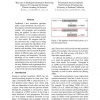Free Online Productivity Tools
i2Speak
i2Symbol
i2OCR
iTex2Img
iWeb2Print
iWeb2Shot
i2Type
iPdf2Split
iPdf2Merge
i2Bopomofo
i2Arabic
i2Style
i2Image
i2PDF
iLatex2Rtf
Sci2ools
78
Voted
COLING
2010
2010
Machine Translation with Lattices and Forests
Traditional 1-best translation pipelines suffer a major drawback: the errors of 1best outputs, inevitably introduced by each module, will propagate and accumulate along the pipeline. In order to alleviate this problem, we use compact structures, lattice and forest, in each module instead of 1-best results. We integrate both lattice and forest into a single tree-to-string system, and explore the algorithms of lattice parsing, lattice-forest-based rule extraction and decoding. More importantly, our model takes into account all the probabilities of different steps, such as segmentation, parsing, and translation. The main advantage of our model is that we can make global decision to search for the best segmentation, parse-tree and translation in one step. Medium-scale experiments show an improvement of +0.9 BLEU points over a state-of-the-art forest-based baseline.
COLING 2010 | Computational Linguistics | Lattice-forest-based Rule Extraction | Major Drawback | State-of-the-art Forest-based Baseline |
Related Content
| Added | 13 May 2011 |
| Updated | 13 May 2011 |
| Type | Journal |
| Year | 2010 |
| Where | COLING |
| Authors | Haitao Mi, Liang Huang, Qun Liu |
Comments (0)

